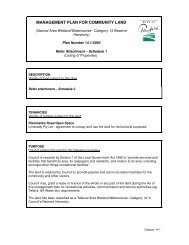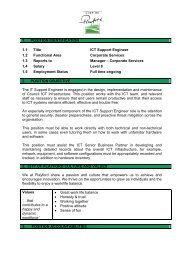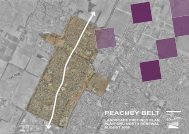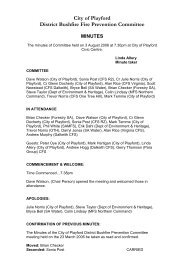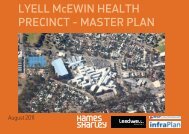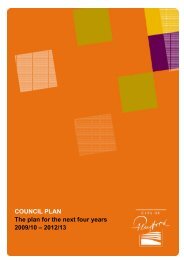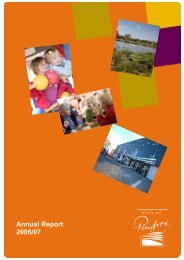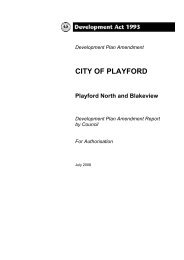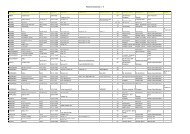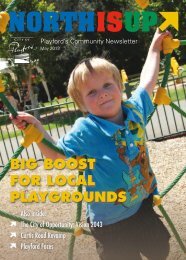Presentation (8367 kb)
Presentation (8367 kb)
Presentation (8367 kb)
You also want an ePaper? Increase the reach of your titles
YUMPU automatically turns print PDFs into web optimized ePapers that Google loves.
Mining and Major Projects SA:<br />
Cultural Heritage <strong>Presentation</strong><br />
Recognising, understanding and working with Aboriginal<br />
Cultural Heritage
AUSTRALIAN CULTURAL HERITAGE MANAGEMENT:<br />
Who we are<br />
‣ ACHM is a multi-disciplinary consultancy firm focussed on working with the<br />
public and private sectors and Aboriginal groups to assist with the management<br />
of cultural heritage. We can help you work within the relevant legislative<br />
requirements to facilitate your project.<br />
‣ Our consultants and associates include:<br />
◦ Anthropologists<br />
◦ Archaeologists<br />
◦ GIS Experts<br />
◦ Historians<br />
◦ Video Ethnographer
AUSTRALIAN CULTURAL HERITAGE MANAGEMENT:<br />
What we do<br />
‣ Some of the work we are<br />
involved with includes:<br />
◦ Cultural heritage surveys and<br />
management plans for land<br />
subject to planning, residential,<br />
industrial or resource<br />
development projects<br />
◦ Native title research,<br />
preparation and review of<br />
connection reports and<br />
material, and Expert Witness<br />
reports<br />
◦ Anthropological, archaeological<br />
and historical research<br />
◦ Geographic Information<br />
Systems (GIS) research, analysis<br />
and mapping
AUSTRALIAN CULTURAL HERITAGE MANAGEMENT:<br />
What we do (cont.)<br />
‣ Our clients include:<br />
• Commercial Corporations; these are often in relation to<br />
mining and infrastructure projects.<br />
• Commonwealth, State and Local Government Agencies<br />
• Aboriginal Organisations<br />
• Legal Firms<br />
‣We have offices in Adelaide, Melbourne and Perth, and<br />
conduct work throughout Australia.
SOUTH AUSTRALIA’S CULTURAL HERITAGE:<br />
Aboriginal Heritage Legislation<br />
‣ In assisting our clients to manage South Australia’s Aboriginal<br />
cultural heritage, we are bound by the South Australian<br />
Aboriginal Heritage Act 1988 (AHA). According to the AHA, all<br />
Aboriginal sites, objects and skeletal remains are afforded<br />
legal protection.<br />
‣ Section 23 of the AHA states:<br />
A person must not, without the authority of the Minister—<br />
(a) damage, disturb or interfere with any Aboriginal site; or<br />
(b) damage any Aboriginal object; or<br />
(c) where any Aboriginal object or remains are found—<br />
(i) disturb or interfere with the object or remains; or<br />
(ii) remove the object or remains.
SOUTH AUSTRALIA’S CULTURAL HERITAGE:<br />
Aboriginal Heritage Legislation (cont.)<br />
‣ If such disturbance or damage<br />
does occur, the maximum<br />
penalty that can be incurred<br />
is:<br />
• $50 000 for a body corporate,<br />
or<br />
• $10 000 or 6 months’<br />
imprisonment in any other case<br />
‣ It is not a legal requirement<br />
for a developer to undertake<br />
a cultural heritage survey<br />
prior to conducting ground<br />
disturbing works. However, it<br />
is highly recommended in<br />
order to avoid inadvertently<br />
disturbing a site, and<br />
breaching the AHA
SOUTH AUSTRALIA’S CULTURAL HERITAGE:<br />
Aboriginal Heritage Legislation (cont.)<br />
‣ It is also required by law that<br />
any owner/occupier of private<br />
land, or an employee or agent<br />
of the owner/occupier who<br />
comes across an Aboriginal<br />
site, object or remains on that<br />
land, must report the nature<br />
and location of the site to the<br />
Minister as soon as<br />
practicable.<br />
‣ Failure to do this can result in<br />
the same maximum penalties<br />
as for disturbance of a site:<br />
• $50 000 for a body corporate,<br />
or<br />
• $10 000 or 6 months’<br />
imprisonment in any other case
ABORIGINAL HERITAGE SITES, OBJECTS AND REMAINS:<br />
What they are<br />
‣ According to the AHA, an ‘Aboriginal site’ or an<br />
‘Aboriginal Object’ is defined as an area of land or an<br />
object:<br />
• that is of significance according to Aboriginal tradition;<br />
or<br />
• that is of significance to Aboriginal archaeology,<br />
anthropology or history<br />
‣ ‘Aboriginal remains’ refers to the whole or part of the<br />
skeletal remains of an Aboriginal person, except for<br />
those remains that have been buried in accordance with<br />
the law of the State
ABORIGINAL HERITAGE SITES, OBJECTS AND REMAINS:<br />
Sites of Significance to Aboriginal Archaeology<br />
‣Some examples of sites of significance to Aboriginal<br />
Archaeology include:<br />
•an area in which stone tools are identified<br />
•a scarred tree (or culturally modified tree), which has<br />
been cut to make a shield, bowl or canoe<br />
•a campsite or fireplace<br />
•a burial site
ABORIGINAL HERITAGE SITES, OBJECTS AND REMAINS:<br />
Sites of Significance to Aboriginal Archaeology
ABORIGINAL HERITAGE SITES, OBJECTS AND REMAINS:<br />
Sites of Significance to Aboriginal Anthropology<br />
‣ A site of significance to<br />
Aboriginal Anthropology may<br />
be an area in which an event<br />
that is part of a ‘Dreaming’<br />
story has occurred, or where<br />
a Creation ancestor has<br />
travelled through.<br />
‣ These places and the<br />
knowledge associated with<br />
them are often secret, and<br />
information may be restricted<br />
according to gender, age, or<br />
level of initiation and<br />
responsibility.
ABORIGINAL HERITAGE SITES, OBJECTS AND REMAINS:<br />
Sites of Significance to Aboriginal History<br />
‣ A site of significance to Aboriginal History is usually an area where a<br />
historical event in the lives of Aboriginal people has occurred; e.g. a mission<br />
site or a place where a massacre occurred.<br />
Ernabella School, children in line outside the school house, SA, 1946<br />
Part of the Charles Guguid collection, National Library of Australia
ABORIGINAL HERITAGE SITES, OBJECTS AND REMAINS:<br />
Objects of Significance to Aboriginal Tradition,<br />
Archaeology, Anthropology or History<br />
‣ Some examples of objects<br />
which are significant<br />
according to Aboriginal<br />
tradition, archaeology,<br />
anthropology and history<br />
are:<br />
• Grind stones<br />
• Hammer stones<br />
• Cutting tools
ABORIGINAL HERITAGE SITES, OBJECTS AND REMAINS:<br />
Objects of Significance to Aboriginal Tradition,<br />
Archaeology, Anthropology or History (cont.)
ABORIGINAL CULTURAL HERITAGE SURVEYS<br />
‣Conducting an Aboriginal heritage survey prior to commencing<br />
ground disturbing work will help to ensure developers avoid disturbing<br />
or damaging any Aboriginal sites, objects or remains.<br />
‣Usually, a team will first visit the survey area to assess the<br />
anthropology of the area, followed by a team who will assess the<br />
archaeology of the area.<br />
‣The aim of the surveys is to identify any Aboriginal sites, to record<br />
these sites, and to consider ways in which they can be managed<br />
throughout and after the ground disturbing works.
ABORIGINAL CULTURAL HERITAGE SURVEYS:<br />
Archaeology Survey<br />
‣During the archaeology survey, archaeologists visit the proposed work area<br />
with members of the local Traditional Owner group.<br />
‣The archaeological survey team attempt to identify any surface archaeological<br />
material by walking along exposed land within the study area. They also assess<br />
the potential for there to be any underlying archaeological deposits within the<br />
area.
ABORIGINAL CULTURAL HERITAGE SURVEYS:<br />
Archaeology Survey (cont.)<br />
‣If any archaeological material<br />
is identified, the archaeologists<br />
record the objects or site<br />
using:<br />
•a hand-held Global<br />
Positioning System (GPS)<br />
•digital photography<br />
•written field notes to<br />
capture the intra-site<br />
details of the site.
ABORIGINAL CULTURAL HERITAGE SURVEYS:<br />
Anthropology Survey and Consultation<br />
‣ Anthropologists also visit the<br />
survey area with Elders from<br />
the local Traditional Owner<br />
group who are knowledgeable<br />
in the ethnography and<br />
mythology associated with<br />
the area.<br />
‣ The group usually traverse<br />
the survey area by vehicle,<br />
and stop at certain vantage<br />
points or areas of significance<br />
to discuss the anthropology<br />
of the area and the impact of<br />
the proposed works on any<br />
sites of significance.
ABORIGINAL CULTURAL HERITAGE SURVEYS:<br />
Anthropology Survey and Consultation (cont.)<br />
‣ If any sites of anthropological<br />
significance are identified within<br />
the survey area, the<br />
anthropologists record the site<br />
using:<br />
• a hand-held GPS<br />
• Digital photography<br />
• written fieldnotes to record<br />
information about the cultural<br />
significance of the site<br />
• video camera (if desired by<br />
the Traditional Owner group)<br />
• audio recording (if desired by<br />
the Traditional Owner group)
ABORIGINAL CULTURAL HERITAGE SURVEYS:<br />
Anthropology Survey and Consultation (cont.)
ABORIGINAL CULTURAL HERITAGE SURVEYS:<br />
Reporting and Recommendations for Site Protection<br />
‣ After the survey is completed, the archaeologists and<br />
anthropologists compile a report including background research of<br />
the area, the results of the survey, the details of any sites of<br />
Aboriginal significance that were recorded, and recommendations<br />
for the conservation and management of culturally significant sites.<br />
‣ Where possible, the various stakeholders will look for ways that<br />
the proposed works can go ahead without impacting on sites of<br />
cultural significance. Recommendations for protecting heritage sites<br />
may include:<br />
• Shifting the proposed work footprint to accommodate protection of a<br />
site of significance<br />
• Engaging members of the Traditional Owner group as monitors during<br />
ground disturbing works<br />
• Following the site discovery procedure
SITE DISTURBANCE:<br />
Application to the Minister to disturb a site<br />
‣If it is not possible to avoid a site of significance, and the developer wishes to go ahead<br />
with the work, an application to disturb the site must first be made to the Minister for<br />
Aboriginal Affairs and Reconciliation.<br />
‣The Minister will then determine whether the site is or should be registered with the<br />
Aboriginal Affairs and Reconciliation Division of the Department for Premier and Cabinet<br />
(DPC-AARD), and whether the proposed disturbance to the site is warranted and should<br />
be authorised.
SITE DISTURBANCE:<br />
Application to the Minister to disturb a site<br />
• Before making such a determination, the Minister must,<br />
under Section 13 of the AHA, consult with the Aboriginal<br />
Heritage Committee, and any Aboriginal organisation,<br />
Traditional Owners or other Aboriginal persons who have an<br />
interest in the matter. In doing so, the Minister must accept<br />
the views of the Traditional Owners of the land or object on<br />
the question of whether it is of significance according to<br />
Aboriginal tradition.<br />
• If a site of significance is to be destroyed, archaeologists may<br />
first undertake a salvage operation, to record the site in its<br />
current state, remove aspects of the site and relocate them<br />
elsewhere in accordance with the wishes of the Traditional<br />
Owner group.
Archaeologists undertaking an excavation of an Aboriginal<br />
site<br />
SITE DISTURBANCE:<br />
Excavation and<br />
Salvage Operations
TRADITIONAL OWNER GROUPS:<br />
What is meant by Traditional Owner<br />
‣ According to the Aboriginal Heritage Act 1998, a<br />
‘Traditional Owner’ of an Aboriginal site or object is:<br />
‘an Aboriginal person who, in accordance with Aboriginal<br />
tradition, has social, economic or spiritual affiliations with,<br />
and responsibilities for, the site or object’<br />
‣ In many cases, the Traditional Owner group will have<br />
lodged a Native Title Claim for a particular area, and<br />
under Commonwealth and State Native Title legislation,<br />
will have the right to be consulted about ground<br />
disturbing work proposed within their claim area.
TRADITIONAL OWNER GROUPS:<br />
Adelaide Region<br />
‣ Several Traditional Owner groups have historically occupied the greater<br />
Adelaide region, including the Kaurna of the Adelaide Plains, the<br />
Ngarrindjeri further south around the Coorong and Lakes, the Peramangk<br />
of the Adelaide hills, the Nukunu further north, and the Narrunga of Yorke<br />
Peninsula.<br />
‣ Several of these groups have submitted Native Title Claim Applications.<br />
Aboriginal Tribal Boundaries in the Adelaide-Fleurieu Peninsula region as researched by Tindale (1974)
THE KAURNA OF THE ADELAIDE PLAINS:<br />
Land and Boundaries<br />
‣ Historical and anthropological references indicate that<br />
the Kaurna held traditional ownership over land<br />
extending from Crystal Brook and the Clare Valley in<br />
the north, to Cape Jervis at the southern end of the<br />
Fleurieu Peninsula, and extending east into the Adelaide<br />
Hills (see Edwards 1972; Groome and Irvine 1981;<br />
Hemming 1990; Tindale 1974).<br />
‣ The Kaurna are the Native Title Claimants for this area<br />
and are currently represented by the Kaurna Nation<br />
Cultural Heritage Association Inc. (KNCHA).
THE KAURNA OF THE ADELAIDE PLAINS:<br />
Land and Boundaries (cont.)
THE KAURNA OF THE ADELAIDE PLAINS:<br />
Population and Occupation<br />
‣ The Kaurna were a very<br />
populous society, with more<br />
than 20 clans living between<br />
the foothills of the Mount Lofty<br />
Ranges and the coastal beaches,<br />
estuaries and wetlands, before<br />
European colonisation.<br />
‣During the summer, the Kaurna<br />
held large gatherings and ceremonial<br />
progressions along the coastline,<br />
during which they would:<br />
•meet and trade with visitors<br />
from other tribes<br />
•fish and hunt<br />
•follow and celebrate the<br />
creation journeys and the<br />
lawgiving of Creation<br />
Ancestors, such as Tjilbruke<br />
(Tindale 1987).<br />
Kuri Dance in Adelaide c. 1844. Probably painted by W. Cawthorne.<br />
Courtesy of the SA Museum.
THE KAURNA OF THE ADELAIDE PLAINS:<br />
Population and Occupation (cont.)<br />
• During the winter, the<br />
Kaurna generally moved<br />
inland to more sheltered<br />
locations in the Mount<br />
Lofty Ranges foot hills<br />
(Tindale 1987:10) and to<br />
villages along the coastal<br />
streams.<br />
• These streams provided<br />
watered access routes<br />
across the land and<br />
continue to be important<br />
sites for the Kaurna, both<br />
archaeologically and<br />
anthropologically.<br />
A camp in the Adelaide Park Lands c.1870 N.B.Tindale<br />
collection, Courtesy of the SA<br />
Museum
THE KAURNA OF THE ADELAIDE PLAINS:<br />
Places of Significance<br />
‣Places of particular cultural significance for the Kaurna exist<br />
throughout the greater Adelaide area and particularly along the<br />
watercourses and the coastline.<br />
‣Some of these places are related to the creation stories of<br />
ancestors such as Tjilbruke, while others are archaeological<br />
campsites and burial sites that indicate historic occupation of<br />
Aboriginal people.<br />
‣Many sites have been disturbed or destroyed by development<br />
since European colonisation. ACHM works with Aboriginal<br />
Traditional Owners and proponents wishing to use the land for<br />
infrastructure, mining and other developments to ensure<br />
cultural heritage is appropriately managed. We also address<br />
European heritage places as they arise.
THE KAURNA OF THE ADELAIDE PLAINS:<br />
Ongoing connection to the land<br />
‣Kaurna people today have a strong, ongoing connection to their land and<br />
places of significance. The Kaurna work to maintain their cultural practices,<br />
particularly through activities at cultural centres like Warriparinga, in Marion.<br />
‣Some of these activities include:<br />
•Canoe building<br />
•Language learning and recording<br />
•Use of native vegetation.<br />
‣Knowledge about Kaurna places, culture<br />
and language is being passed down from the<br />
Elders to the younger Kaurna people, and<br />
cultural heritage surveys provide an additional<br />
opportunity for this to occur.<br />
Golden wattle (minnow) sap, known as mangka,<br />
can be used as an adhesive, as well as for<br />
‘behaviour modification’ when placed in<br />
children’s mouths, or for taking out loose teeth.
FURTHER READING<br />
• Aboriginal Heritage Act 1988 (South Australia)<br />
http://www.austlii.edu.au/au/legis/sa/consol_act/aha1988164/<br />
• Edwards, R. 1972. The Kaurna People of the Adelaide Plains. South<br />
Australian Museum, Adelaide.<br />
• Groome, H. and J. Irvine. 1981. The Kaurna, First People in Adelaide.<br />
Tjintu Books, Adelaide.<br />
• Hemming, S. 1990. ''Kaurna' identity: a brief history', Journal of the<br />
Anthropological Society of South Australia, 28(2):127-142.<br />
• Native Title Act 1993<br />
http://www.austlii.edu.au/au/legis/cth/consol_act/nta1993147/<br />
• Tindale, N.B. 1974. Aboriginal Tribes of Australia. Australian National<br />
University Press, Canberra.<br />
• Tindale, N.B. 1987. 'The Wanderings of Tjirbruki', in Records of the<br />
South Australian Museum, 20: 5-13<br />
• Warriparinga Wetlands Cultural Centre<br />
http://www.qguide.com.au/story/adelaide/Warriparinga-Wetlands-<br />
Cultural-Centre.php



